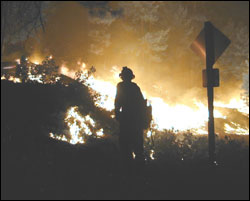The war in the woods has become the fight over the fire line. Before, timber interests, federal officials, and environmental advocates fought over which trees to cut. Now they fight over which fires to suppress, which forests to try to make “fire safe,” andit all comes aroundwhich trees to cut, ostensibly to make sure they don’t burn. That fight has become the latest flashpoint environmental issue as the Bush administration strives, under the rubric of “healthy forest” preservation, to undo a Clinton forest plan that drastically reduced cutting on federal land, where most of the remaining old growth is, and to undo three decades of environmental rules. It’s come to a showdown as the U.S. Senate wrestles over a Bush-backed “forest-restoration” measure, passed by the House last May, and various Democrat-sponsored “community fire protection” bills which, to various degrees, propose to spare forests and actually protect the people who live by them.
MEANWHILE, ANOTHER long fire season is wrapping up, attesting to both the cost and futility of fighting wildfires the old-fashioned way and to the difficulty the U.S. Forest Service has, despite good intentions, in breaking with that way. New research by a local forest geographer paints a devastating picture of the extent to which Smokey Bear and human antifire crusaders have altered the natural burn cycles of America’s forests, creating an enormous ticking firebomb.
Just about everyone concedes the basic principle, or at least gives it lip service: Absolute fire suppression is impossible, and decades of trying have allowed an enormous lode of dense undergrowth, woody debris, and other tinder to accumulate throughout the Westa pyromaniac’s dream on a continental scale. Since 1972, when, for the first time, federal foresters intentionally let a lightning-strike fire burn, the U.S. Forest Service has acknowledged, in word and sometimes in deed, the need to let forests burn periodically.
But recognizing natural fire cycles hasn’t reduced outlays to stamp them out. In the five years through 1999, the Forest Service spent an average of $425 million a year on fire suppression. In 2000, which the press wrongly dubbed the biggest fire year in 50 years, it spent (depending on which official tally is correct) $1.4 billion or $1.6 billion. Since then, firefighting outlays have ebbed and risen with the volume of fires$952 million in 2001, $1.4 billion in 2002, more than $800 million so far this yearbut remained at double or more the late-1990s average. Anne Jefferey of the National Fire Information Center in Boise, the feds’ nerve center, gives several reasons: “Costs have gone up, especially aircraft and insurance. It’s warmer, with more areas affected by drought. Communities are getting closer to fires.” The ante keeps getting raised.
One of this year’s costliest firefights was waged against the three-month, 81,343-acre Farewell Creek blaze in the Pasayten Wilderness in north-central Washington. As of mid-September, the Forest Service had spent nearly $40 million fighting this fire, which stayed some 12 miles from the nearest community and several miles from the line that firefighters cut to stop it. But Robin Mario, a spokesperson for Okanogan National Forest, where the Farewell Creek fire started before moving into the Pasayten, says officials were obliged to “make sure it didn’t move into Canada,” north of the wilderness.
Tim Coleman, the executive director of the Kettle Range Conservation Group, snorts at such efforts. “Generally, the Forest Service throws a lot of money at fires, and then the rain and snow come and put them out. The British Columbia government has spent the equivalent of what was spent in the Farewell Fire on the entire province!” Despite the Forest Service’s avowed let-it-burn philosophy, Coleman contends, “their expertise is in putting fires out. Only a handful of incident commands know how to let a fire burn and manage it.”
Michael Murray, the park ecologist at Crater Lake National Park in Oregon, says a catch-22 prevents his agency and others from developing the necessary expertise in managing rather than fighting fires, which, if not done right, can lead to disaster. That expertise comes with experience. “But since we’re allowing so few wildland-use fires [the official term for letting naturally occurring fires burn], we’re not training new specialists.” Lacking those specialists, officials don’t dare risk allowing more fires. And on the cycle goes.
Murray, who holds a doctorate in fire ecology, suggests that habit and inertia, and the culture of firefighting, help perpetuate it. He even voices the ultimate heresy: “I question why we have smoke jumpers. It’s one of those romantic traditions in the Forest Service. They’re very talented and smart and take a lot of risks. But they tend to put out the most remote fires. And those fires represent the greatest potential for restoring ecological balance.”
Trees that need fire to generate or incubate are declining. Ponderosa and lodgepole pine are the best-known fire-dependent species. Some have suggested that white pine, which is declining, might also be helped by fire. “At Crater Lake, we’ve confirmed that,” says Murray. “Fire suppression leads to general homogenization of the landscape.”
EVEN THE BUSH administration goes halfway to conceding the point. A “fact sheet” on its Healthy Forests Initiative from the Agriculture and Interior departments declares that “the long-term solution to catastrophic wildfires is to address their causes by restoring fire to fire-adapted ecosystems through reduction of hazardous fuels and returning our forests and rangelands to healthier conditions.” But that formulation has the cart pulling the horse. Reducing “hazardous fuels” doesn’t “restore fire,” though when done near habitations it reduces the impacts of wildfires on humans. Nor does making forests “healthier,” a
term that, like fuel reduction, means logging. Rather, as fire ecologists inside and outside government explain with Cassandra-like exasperation, fire is what reduces fuel lodes and returns forests and rangelands to health. Nothing gets rid of a pest infestation like a good blaze.
Nevertheless, the administration’s Healthy Forests effort is directed not to building the capacity to safely manage fires, but to putting them out and to “hazardous fuel reduction”i.e., cutting. It proposes about four times what the budget of 2000 allowed for each. Conservationists who have watched previous “thinning” of supposedly downed and diseased trees turn into raids on otherwise-protected old growth expect little better from the current regime. And they’re even more alarmed at the Healthy Forests provisions to exempt “priority” forest-thinning projects from standard environmental review and public disclosure and to drastically limit administrative appeals, judicial challenges, and injunctive relief.
IN MAY, HOUSE Republicans passed the Bush plan, cheerily titled the Healthy Forests Restoration Act, at a gallop and without a hearing. Senate passage seemed a done deal, but greens and forestry scientists have rattled enough cages to raise resistance. Three contrary bills have been introduced in the Senate, including one whose sponsors include Washington Sens. Patty Murray and Maria Cantwell, and a fourth was expected from Arizona Sen. John McCain. The greens have rallied behind the Forestry and Community Assistance Act from Democrats Patrick Leahy of Vermont and Barbara Boxer of California. It would fund fuel reduction on state, tribal, and nonindustrial private lands, as well as federal lands, and would give priority to the “community protection zone” surrounding habitations and water suppliesan emphasis favored by ecologists such as Murray at Crater Lake National Park and in rural communities such as Roslyn, Wash.
Roslyn is the poster child for the new prevention philosophy. With $340,000 from the Forest Service, Kititas County’s FireWise project cleared a 150- to 200-foot-wide fuel break around the towns of Roslyn, Ronald, and state Highway 903. Crews didn’t try to reduce the fuel load; rather, they moved it and spread it so fire wouldn’t burn out of control if and when it was ignited. And they left trees standing. The result was a shaded, open, parklike woodselegant and safer.
WHAT BUSH PROPOSES is much more ambitious than building buffers around towns and making sure residents sweep their roofs. This year, the administration plans to “treat” (i.e., thin) 2.6 million acres of forest. That’s a lot, double the acreage “treated” in 2000, unless you count fire as treatment. But it’s just a drop in the 190 million acres the administration has identified as vulnerable to fire and eligible for treatment. And for Michael Medler, a fire ecologist and geography professor at Western Washington University (and a former firefighter), it’s still pathetically short of the area formerly “treated” by fire, before Smokey and friends got in the way.
According to records kept by the National Interagency Fire Center in Boise, the amount of ecosystem acreage (forest and otherwise) burned nationwide in the 1930s was about 39 million a year. Fire suppression, which hit its stride in the 1960s, has brought that down to about 3 million acres a year today, half of that in the West. Even after allowing for buffers around communities, Medler says, “We should burn about 13.5 million acres a year in the West. Falling behind 12 million acres a year for 40 yearsthat’s a lot of acres.”
Medler calls that “the fire deficit,” and it’s hard to avoid comparisons to the galloping federal budget deficit. “The only way you’re going to clear it is with fire,” he says. “These forests co-evolved with fire.”








